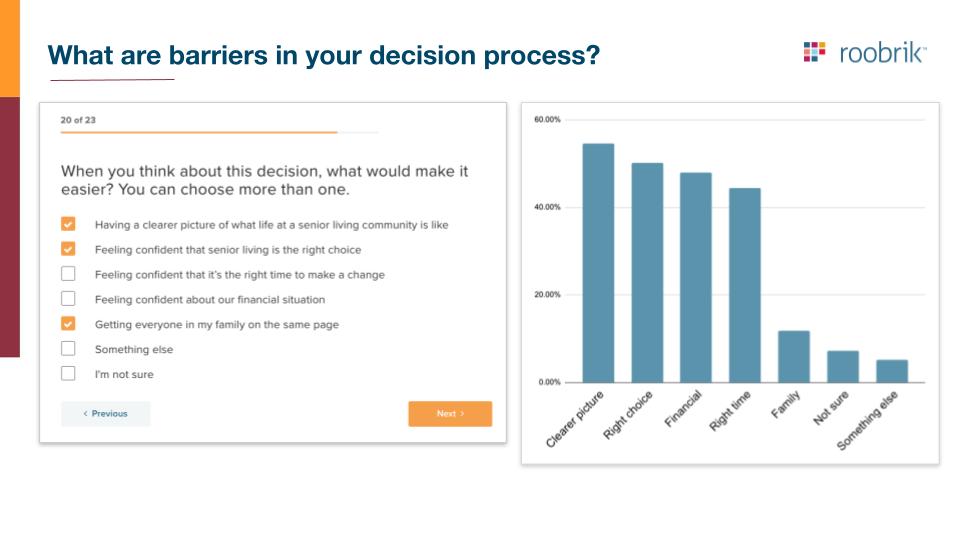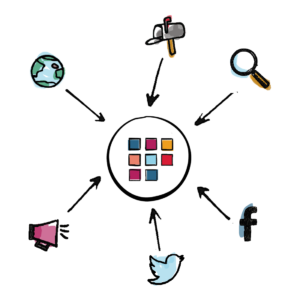Tracking Success, One UTM at a Time
With more and more of our clients using Roobrik across multiple channels (website, email, social, search), we’ve been getting more questions about why we provide unique links for each channel, and what that means for the data we can provide in return.
Marketers understand the importance of measuring the success of every tactic they try. After all, we know we’ll be asked to justify expenses and predict results. That’s why it’s important to test, measure, and optimize your digital efforts. Roobrik uses Google Analytics to track and report on the traffic to your assessment tool so you can understand what’s working. Below are some tips for using Google Analytics UTM parameters so you can get the most out of your Roobrik reports.
What *are* UTM parameters anyway?
Put simply, UTM parameters are tags added to a web address (URL).
When someone clicks on a URL, Google Analytics captures the details about where they came from based on what’s in the UTM parameters. So, whether you’re promoting a webinar, a free whitepaper or simply driving traffic to your website, if you create unique UTM parameters for the link, you’ll know just how your campaign performed.
Here’s an example of a link to a Roobrik assessment:
https://tools.roobrik.com/demo/care/start?utm_source=facebook&utm_medium=cpc&utm_campaign=demo-roobrik&utm_content=may
In this example, we can see the user came from a Facebook ad campaign that was run during the month of May just based on the UTM parameter values. If we break down the link, we see four parameters included in the URL above.
utm_source=facebook
The source parameter is meant to identify the specific site, advertiser, publication, etc. that is sending the traffic to your Roobrik tool. In this case it’s an ad campaign running on Facebook, so we’ve made the source value “facebook.”
utm_medium=cpc
The medium parameter is used to specify the marketing channel (website, social, email, paid advertising, etc.) associated with the link. In this example, it’s a paid campaign so we’re using “cpc” which stands for cost-per-click and is a common way to identify paid traffic.
utm_campaign=demo-roobrik
The campaign parameter is generally used to differentiate between multiple campaigns that may be running. In the case of campaigns pointing to Roobrik, we can report back to you most easily if you use the same campaign parameter value across all links pointing to your Roobrik tool. Our standard naming convention is to use “clientname-roobrik.” In this case our client’s name is “demo” so the campaign value is “demo-roobrik.”
utm_content=may
The content parameter is generally used to distinguish between similar content or links within the same piece of content within a campaign. In this case, you may want us to be able to easily compare ads you ran in May against previous or subsequent campaigns, and we can do that by identifying the month in the content parameter.
We sometimes use this parameter to identify pages on your website that send traffic to Roobrik so we can tell you how many people come from the home page placement, a community page, or a living options page, for example.
Why does Roobrik enthusiastically encourage me to use UTM parameters?
Since your Roobrik tool lives on our domain (tools.roobrik.com), once someone clicks a Roobrik button or other CTA on your website, email, social media post, or in any other channel, you will not be able to track Roobrik activity in your own analytics platform. But, if you use UTMs, we’ll have visibility into where the person came from and what happened next, and we’ll also be able to help you identify patterns that develop from specific channels.
What happens if I use the same link everywhere I link to Roobrik?
While it’s not a major catastrophe if you just use one link across every channel/campaign, what we can tell you about your traffic is much more limited. Let’s say we’ve provided you with a tagged URL for your home page CTA placement and now you’ve decided to use the Roobrik assessment to engage families in a social media ad campaign. If you use the same link that we’ve given you for your home page, all the traffic that comes from your ad campaign will look to us like it came from your home page. Of course you have visibility into impressions and clicks on the platform where your ads are running, but what happened after the click will be a question mark. We won’t be able to answer the question, “Can social media campaigns using Roobrik result in qualified leads?”
Do I have to contact Roobrik to get tagged tracking links?
Not necessarily, but it’s often easier for our clients if we provide exactly what they need. It also lets us keep track of what kind of activity we should be expecting to see for your communities. If we know ahead of time that you’re running a re-engagement email campaign to cold leads, we know that will be of interest to you on the next report and we can be sure to break out the data and patterns when we send along your report.
Ready to try Roobrik in new channels, other than your website?
We’re here to help — and not just with UTM parameters. Contact us and we’ll give you some insight into what tactics have been successful for others, what tactics are worth trying, and, of course, we’ll get you set up with those not-so mysterious UTM parameters.
Want to dive deeper into UTMs and Google Analytics? Here’s an article from Google to get you started.





